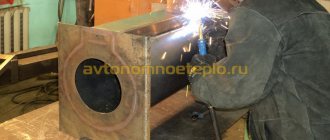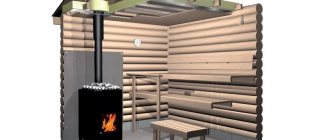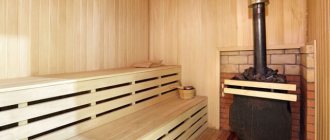- Label information
- Elements of smoke exhaust systems
- Types of installation
To prevent carbon monoxide from accumulating in the steam room, it is necessary to consider smoke removal for the bath complex during the construction stage. Correctly selected and installed chimneys determine the level of comfort in the steam room even more than the structure itself. In this article we will tell you which pipe is best for a stove chimney in a bathhouse and what to look for when choosing materials and installation method.
Selection and installation of pipes in the bathhouse
A comfortable microclimate in a bathhouse depends on how correctly the chimney is installed.
After all, a pipe for a bathhouse is not only a means of removing carbon monoxide, but also fire safety and the health of people in the room. Stainless steel pipes for sauna stoves
The device itself can be installed with your own hands; there is nothing complicated in the process. The main thing is to prepare properly: choose the right material and follow all installation recommendations.
Choosing material for the chimney
The stove pipe in the steam room can be made of various materials, but it is most advisable to opt for stainless steel products. Important characteristics that allowed stainless steel chimneys to become widespread:
- High temperature resistance;
- The structural elements are lightweight, which simplifies DIY installation;
- Resistance to condensation;
- Resistance to aggressive environments (various acids that make up carbon monoxide);
- Good traction thanks to the perfectly round cross-section;
- No accumulation of soot on the internal walls of the chimney;
- Easy to operate;
- Affordable price.
Chimney for a bathhouse made of stainless steel
Installation of asbestos-cement pipes is undesirable, since they do not meet fire safety standards for a bathhouse. When exposed to high temperatures, they can collapse and thereby cause a fire in the room. The result is dubious savings with health risks.
A ceramic chimney is a reliable and durable design that can withstand temperatures up to 600 degrees, but it is not suitable for a bathhouse. This is due to the excessive weight of the device, which only a capital building can withstand.
Stainless steel is the best choice of material for a sauna smoke exhaust. Reliability, durability, ease of installation with your own hands - these are its main trump cards.
Rating of the best manufacturers
Before purchasing a chimney, it is recommended that you check out the best brands that offer similar products. They have proven themselves well, and each has certain pros and cons.
Phoenix
The company offers customers reliable and durable designs. The company itself is located in the Moscow region, and consumers are attracted by the high quality of chimneys and a long warranty period. To achieve this, the company uses the best equipment and makes devices using modern technologies.
All materials undergo 3D modeling, plasma cutting and TIG welding. As a result, it turns out that you can make a chimney of any type and shape. The warranty period is 15 years, the company has all the necessary certificates and documents that confirm quality.
- Use of modern technologies in the production of chimneys.
- European equipment.
- The warranty period for goods is 15 years.
- Easy installation.
- Weak resistance to corrosion.
- The quality of the seams is not the best.
Volcano
The company began production of modular chimneys in 1996. The range of chimneys is very large; there are models for an ordinary home or industrial facilities. Employees constantly monitor new products on the market and exchange experiences with European specialists. The plant uses modern technology and the best raw materials, which allows it to create competitive products.
The products fully comply with fire safety; the company has all the necessary certificates and licenses. The brand's clients include Toyota and Nissan. Experts note high quality and a long warranty period.
- Application of modern technological base.
- Product warranty is 50 years.
- Use of high quality raw materials.
- We have our own laboratory.
The only disadvantage is the high cost.
Ferrum
The manufacturer offers a large selection of components for smoke removal. The production is located in Voronezh, the brand creates not only pipes and chimneys, but also various plugs, adapters and additional elements for arranging the system. The main raw material is stainless steel, which undergoes a series of procedures to improve appearance and durability. The quality is at a high level, which is confirmed by certificates.
- Use of high quality metal.
- Availability of a large assortment.
- Possibility of purchasing individual components in a large range.
- Simple and convenient installation.
- Beautiful appearance.
The only disadvantage is the cost.
Elites
This company is considered a leader in the domestic market. All efforts are aimed at producing chimney systems at an affordable cost. Stainless steel is used in manufacturing, which helps to increase service life. All products are used at home (private property) and in production. The products are suitable for the most ordinary and simple potbelly stove, as well as modern boilers that heat large areas. Experts highlight the ease of installation, the evenness of the welded parts and the shine of the pipe. But customers note incorrectly selected insulating materials, as well as thin pipe walls.
- Acceptable pricing policy.
- Easy installation.
- High quality seams.
- Wide range of use.
Among the minuses are only design flaws.
CRAFT
A Russian company with quite a bit of experience, but high-quality products for heating systems. All products are sold only for the domestic market, great emphasis is placed on the quality of materials and the best technology. Chimneys are made of metal that does not corrode, and its processing is carried out using modern machines. Experts highlight the high quality, reliability of structures and their durability, which is confirmed by user reviews.
- Use of very high quality materials.
- Using the best technological base.
- Modern equipment.
- Reliability of goods.
ROSST@IN
The company is located in Moscow and produces chimneys. We have quite a lot of experience, which allows us to produce high-quality products for boiler rooms and private housing. Products are manufactured using new developments and technologies. In the country, this company ranks first in sales. Quality and reliability are at a high level, but you have to pay for it.
The only downside is the high cost.
Termofor
The brand first appeared in 2003 and received its award just a year later. In the assortment you can see different products, including stoves, boilers, tanks, chimneys and all components for them. Experts highlight the excellent performance of the staff and the level of the technological base. When choosing this company, you should be careful, since there are many fakes, in addition, the products are not presented in all regions of the country.
- Application of modern technologies.
- Great equipment.
- Qualified staff of workers.
- Large selection of goods.
- High quality.
Performing device isolation
Installing a stainless steel chimney with your own hands is very simple - you just need to connect the elements in series from the bottom up. Manufacturers of modular stainless steel systems provide a bell at the end of all component parts. It is also necessary to ensure that all elements that go outside have high-quality thermal insulation. The easiest way is to select ready-made modular “sandwich” elements for installation on the street, as well as in places where the roof or wall passes through.
You can make insulation yourself. To do this, the chimney must be wrapped with a layer of basalt wool, and an external contour made of any metal must be installed on top; the cheapest option is galvanization. Essentially, you need to make a homemade sandwich.
Properly performed thermal insulation is necessary for the following purposes:
- Reducing the temperature of the outer pipe;
- Reduced risk of condensation;
- Acceleration of the pipe heating process;
- Increased traction.
Briefly about the main thing
The main questions when choosing a pipe for a bathhouse are which one is better, safer, more practical, cheaper, more durable. Each owner has his own requirements, so their choice may vary. First you need to decide where the chimney will be installed - inside or outside, and then select it based on the material it is made of. The most practical and durable option is ceramics, but it is also the most expensive. The cheapest pipe is made of ferrous metal, but it is susceptible to corrosion. The optimal solution is a modular chimney made from a sandwich pipe. Regardless of the type of pipe chosen, it is necessary to calculate its diameter and length and select component materials for installation and insulation.
Source
Organization of passage through the roof
The most critical stage of installation is the passage through the roof. After all, cutting a hole in the roof of the steam room can disrupt the hydro- and thermal insulation of the roofing pie, resulting in leaks and destruction of the rafters of the building. Following these recommendations will help you make the right passage through the roof:
- The hole on the roof must be designed in such a way that the distance between its walls and the pipe is about 10-13 cm.
- Make a wooden box on the roof in the place where you plan to install the chimney.
- Fill the entire space that separates the chimney from the inner duct with non-combustible material. In this case, stone wool is suitable.
- Press the waterproofing layer with sheathing bars.
For proper waterproofing, small cracks in the roof can be sealed with silicone-based sealant. Larger cracks can be sealed by installing a special element - a passage, which is located at the point of exit through the roof.
Chimney passage through the roof
The roof passage is an apron-cap, which consists of a steel base and a rubber tip.
The passage is put on the pipe and securely fixed to the roof. Too much effort when shrinking the apron onto the pipe is not required; it can break the tightness of the connection and cause a roof leak.
Cleaning
The sauna chimney is cleaned at least twice a year - in spring and autumn. There are a number of reasons for this: condensation formed, foreign objects entering the chimney, but often the chimney is cleaned of soot and soot. The latter depends on the type of fuel used: special briquettes or European firewood slow down the accumulation of soot, but wood fuel increases the frequency of cleaning.
Today there are three popular methods of cleaning a chimney. A traditional means of cleaning a chimney is a brush, which can be bought at any hardware store or made from scrap materials.
To make this simple device, you will need a broom with plastic rods, a washer, a self-tapping screw and a cable one and a half or two meters long with a load of two to three kilograms. The process of making a ruff looks like this:
- The broom rods are placed in boiling water to soften them, then they are bent in different directions and distributed evenly.
- Fix the straightened rods using a washer and a self-tapping screw.
- At the base of the ruff, a cable with a load is secured with brackets.
- The final stage is adjusting the size, because the brush should be slightly larger than the chimney. A template cut out of cardboard will help you determine the size correctly.
Cleaning the chimney with a brush is very simple. A weight is lowered into the chimney, then a brush, and then the pipe is cleaned with progressive movements. Another “at-home” cleaning solution is a hose.
Before cleaning the chimney with it, first prepare a place near the stove, pull the hose through the pipe and clean it, pulling it in different directions. At the same time, the hose is good for cleaning soot and soot, and the brush also removes foreign objects.
Folk remedies like potato peelings or combustible fuel are also simple and effective. In the first case, a bucket of potato peelings is thrown into a hot oven (less is possible - it all depends on the internal dimensions of the oven). The starch released from the cleaning reacts with soot and it removes itself within two to three days. True, experts advise cleaning the chimney again with a brush or hose.
Highly flammable fuel is dry aspen firewood. Open the ash pan, the chimney valve, the combustion chamber door and maintain the fire for two to three hours. During this time, the soot and soot burn out completely. For such cleaning, the chimney must withstand temperatures of more than a thousand degrees.
Modern liquid and solid chemicals, which are placed in the firebox along with firewood or coal, are gaining popularity. They quickly clean the chimney, are available, inexpensive and safe.
To prevent blockages, it is enough to burn aluminum foil along with the fuel once every ten fireboxes. It is important that it burns and not just flattens from the heat.
Cleaning a stainless steel chimney
No matter how good the material used to make a chimney is, there will come a time when it becomes necessary to clean it. To carry out continuous cleaning of the smoke channel, you can use various methods:
- Clean the pipe mechanically using a specially designed brush.
- Using chemical cleaning agents.
- Cleaning the chimney is a simple but effective method - pour boiling water, and then heat the stove for a long time to separate the soot.
Types of smoke exhaust structures
The chimney for a steam room can be external or internal. In our country, you can often find internal options. Among their advantages is the absence of violation of the architectural style, as well as saving heat in the room.
External systems are more like American traditional chimneys. They were previously used by Americans on their ranches. They have a rather interesting appearance. If you decide to build an external solution, then there is no need to make a hole in the roof and ceiling, which definitely has advantages. The wall for the chimney inside must be no less than 12 cm thick, and for the outer wall the thickness must be at least 38 cm.
Video description
This video contains complete information about AVT chimneys, which are a product of such joint production:
Among similar products, it is worth noting the products of such joint ventures as:
- Shidel;
- Wolfshäuer;
- Ecoosmosis;
- Hymen.
Due to the fact that insulating elements and external blocks are produced locally and do not require transport and customs costs, the cost of chimneys of these brands is lower than that of completely European ones. But if you prefer completely imported products, then they are represented on our market by the following companies:
- Tona (Germany);
- Marshal (Czech Republic);
- Effe 2 (Italy).
Popular schemes for installing sauna chimneys
How is the smoke exit structure arranged? Any element is a structure made of pipes, flanges, and fasteners. The main requirement for this building is the ability to operate at high temperatures without any changes in the properties and emissions of combustion products.
To prevent the chimney for a bathhouse from losing large amounts of heat, it is located as close as possible to the inner wall.
When there is more than one stove in a steam room or bathhouse, then each of them must be equipped with its own chimney. Otherwise, the thrust will lose strength. Smoke exhaust system specialists recommend the following. In cases where it is impossible to build several systems for stoves, a cutting system must be installed at a height of approximately 75 cm. It is also important to ensure that the inner surface of the future chimney is as smooth as possible. If there are any roughness inside, soot will accumulate on the walls. This may increase the risk of fire.
The simplest chimney
This element will be based on a stainless steel pipe. In addition to this, you need to prepare one elbow with a diameter of 20x120 cm from galvanized steel, two elbows of 16x120 cm each, three of stainless steel of 16x10 cm each. You will also need a tee with a diameter of 16 cm and a plug for it. You also need a fungus that is the right size. The diameter of the chimney for the bathhouse in this particular case will be 16 cm.
The prepared pipes should be connected to each other using self-tapping screws.
The section of pipe that will be outside is wrapped with basalt wool. The layer should be approximately 16 cm. You should also additionally wrap the cotton wool with asbestos cord. Then a pipe with a diameter of 20 cm is connected, which is fixed and thoroughly coated with bitumen mastic. An asbestos cord is placed in the gap between the two pipes. This is necessary for protection from rain.
This is how you can independently design and install stainless chimneys for a bathhouse. This is a very affordable solution.
Possible mistakes
It also happens that despite all the correctness of the calculations, an error creeps into the design of the chimney. There is no reason to panic, but it is important to know how to eliminate the unpleasant drawback.
Smoldering firewood, a soot-covered fire door and wisps of smoke indicate low draft. This happens when there is heavy pollution or a short chimney. In the first case, the chimney is cleaned, in the second, it is enlarged using insulated pipes. If the draft remains the same, change the diameter of the chimney .
Plumes of smoke escaping from the air holes indicate that the thrust has stalled. This happens when the chimney pipe is not installed correctly or its upper part is not insulated enough. Often the solution to the problem lies in insulating the chimney.
If the oven hardly heats up, adjust the draft.
To do this, install a damper, heat removal modules with metal fins operating on the principle of a radiator, or double-walled heat-storing modules with stone chips or perlite sand instead of insulation.
Strong heating of individual parts of the chimney indicates shrinkage of poor-quality thermal insulation . The structure should be replaced, and as a temporary solution, assemble a heat-insulating casing from GVL and fill it with stone wool.
Special deflector attachments help correct errors in the chimney design. The weather vane nozzle reduces the risk of draft overturning and enhances it. The rotating one is practically unsuitable for chimneys, since in calm conditions it impairs draft, and frost in winter blocks the path of smoke. An electric smoke pump allows for quick kindling and reduces draft.
Installation of chimneys for a bathhouse for a metal stove
After the installation of the stove is completed, you can immediately begin installing the chimney. The first step is to attach several expansion supports to the pipe. It’s good if these are pipes made of asbestos or “Sandwich”. The latter can withstand significantly higher temperatures, unlike other analogues. However, such a pipe should not be exposed to direct flame. That is why a steel pipe is installed first, and then, after the first bend, a sandwich or asbestos-cement structure is installed.
Now all that remains is to organize the protection of the upper part from the rain. A plug may be suitable for this. Another one is mounted on the pipe below, which will then facilitate the process of draining condensate and cleaning.
If the oven is brick
This chimney for a bathhouse is easy to build with your own hands. When the row of masonry covers the stove, the construction of the chimney system begins.
So, on the 21st row of brickwork it is necessary to form two channels. They will then be merged. Next, on the right you should block the space above the core. The gap between the core and the masonry will be 2-3 cm. Any voids are filled with mineral wool insulation. With the 22nd row of masonry, the opening will already be closed, and after that you can begin to lay and shift the channels to the middle. To prevent this ceiling from cracking in the future, it is advisable to lay another row of masonry above the stove core.
Next, the chimney will begin to narrow. Valves are installed here. They are made one above the other. Now the brickwork will go into fluff.
For those who have managed to build a brick oven, making a chimney will not be difficult. The main thing is that no cracks arise. Also, the standard for the cross-section of the pipe should not be exceeded. Otherwise, the gases will cool quickly.
How to make a chimney for a bath through the ceiling
Often modern baths are built from pine. This wood sometimes overheats. The process of smoke passage must be created with maximum attention. The wall must be fenced with any non-combustible materials. You can strip steel sheets; mineral wool or brickwork will also work.
Another effective method of protection is a special ceiling-passage assembly.
At the next stage, the pipe is erected above the roof. Its height must be at least 1.5 m. When it passes through the roof covering, it is necessary to apply a sealing cover. Using this operation, you can hermetically connect the chimney pipes.
In order to get good traction and long service life, you need to clean the pipe from accumulated soot and debris once every six months. And then the bathhouse will delight its owner for a very long time.
Bath pipes
The chimney plays a very important role in creating a comfortable microclimate. The choice of pipe material for it is also important. A chimney is not only a smoke exhaust system, but also safety in case of fire, as well as health. Let's find out which chimneys are best for a bathhouse.
The pipe in the steam room can be made from a variety of materials. However, it is best to use stainless steel for this. This material has a lot of important characteristics, such as resistance to high temperatures, light weight, ease of use, good traction, and resistance to aggressive environments. The best chimney for a bathhouse is made of stainless steel.
Asbestos cement pipes are not very desirable. They poorly comply with fire safety standards.
Ceramics are reliable and durable. Such chimneys can withstand high temperatures up to 600 degrees. But these pipes are also poorly suited for a bathhouse. It's all due to the heavy weight. They are definitely not suitable for wooden structures.
This is a modern option. Chimneys for wood-burning saunas are assembled from it.
These are the types of chimneys for sauna stoves, and anyone can make such a design with their own hands.
The best stainless steel chimneys with roof passage and top outlet
These are structures for connection to boilers and fireplaces that have an outlet for gases from the combustion chamber in the upper part of the body.
From there, the system is mounted directly onto the roof, which requires partial dismantling of the roof, but requires a minimum of materials for transitions and connections, due to the straight trajectory. To select, it is important to calculate the length of the structure with the elevation above the ridge.
Ferrum set 115 mm, 0.8 mm - for any fireplace
This is the best stainless steel chimney for a home fireplace due to its direct connection and the optimal diameter for connecting to the outlet of 115 mm. Inside there is stainless steel with a sealed weld that will not allow condensation to pass through.
This is followed by a thick layer of mineral wool with a density of 120 kg/m3, which protects the attic floor and roof from fires. The outside of the chimney is wrapped in laser-welded galvanization, which eliminates damage to the galvanic layer.
Pros:
- all parts for installation in the kit, including ceiling elements for the roof;
- the insulating layer is resistant to temperatures of 700 degrees;
- an insulation thickness of 40-50 mm will prevent the surrounding materials from igniting from hot smoke and heat from the pipe;
- suitable for burning wood (rising ash will not damage or burn through the inner layer);
- screws included;
- stainless steel head that protects the outlet from blocking with snow;
- the package comes with a sealant that can withstand 1200 degrees;
- the box contains 7 sheets of basalt wool and 5 clamps for connecting high structures;
- pre-furnace sheet and stainless steel screen;
- AISI 439 steel on both parts of the pipe (on the one in the room and on the one outside on the roof).
Minuses:
- the thickness of the stainless steel connecting to the fireplace is 0.8 mm, and the cross-section of the pipe wall on the street is 0.5 mm;
- the pipe leading from the fireplace is not covered with insulation (protection starts only from the ceiling), so you can get burned on it;
- the cost of the entire set is 27,000 rubles.
Set Dymok 115mm, 0.5 mm - the most affordable option
This is the best stainless steel chimney at the most affordable price of 11,000 rubles for a complete set. Inside the sandwich structure there is stainless steel with a wall section of 0.5 mm, which is resistant to deformation thanks to the dense winding of Rocwool basalt wool and a galvanized layer on the outside.
The pipe connection is made using TIG welding technology, which provides a strong seam with minimal soot collection on the protrusions.
Pros:
- the price is one of the most attractive 11,000 rubles;
- The set includes an insulated umbrella that protects against precipitation;
- 4 stainless steel clamps for assembling a long pipe into a single unit;
- adapter from single-circuit structure to double-circuit structure;
- roofing adapter (master flush) included;
- 1 m of starting pipe without insulation and 3 m of double-layer pipe for leading to a high roof;
- sandwich thickness 40 mm;
- high quality AISI 439 stainless steel.
Minuses:
- there is no roof insulation, so you will have to purchase additional materials separately;
- only one fastening to vertical structures;
- metal thickness along the entire length of the pipe is 0.5 mm;
- Suitable for burning with coal or gas, but it is better to use wood rarely, so as not to heat up the thin walls too much.
Ferrum set 200 mm, 0.8 mm - for a powerful heating system
This is the best option for installing a heating system not only in a private home, but also in an office building, because the internal flow diameter is 200 mm, which can satisfy the needs of a serious boiler. The wall thickness of 0.8 mm has sufficient rigidity for long-term performance.
Pros:
- insulator filling density 120 kg/m3;
- high-strength stainless steel;
- withstands temperatures up to 700 degrees;
- simple assembly of the socket system;
- sealed internal seam;
- insulation thickness 50 mm;
- 7 meters of pipe for high reach;
- flange for passage through the ceiling;
- a large head covering not only the inner pipe, but also the outer one;
- 8 basalt wool slabs for attic insulation;
- 2 fasteners and 9 clamps included;
- stainless steel screen 1x1 m.
Minuses:
- the large outer diameter of the pipe 280 mm requires a large hole;
- price 42,000 rubles.
Expert advice
It is necessary to choose pipes in which the thickness of the outer metal layer is 1 mm (not 0.5 mm). It’s very easy to check - for a product with a thin wall, the wall bends if you squeeze it with your hands.
When installing sandwich structures, it is necessary to use a special sealant for high operating temperatures (automotive sealant with an operating temperature of 500° is not suitable).
If the pipe rises more than one meter above the roof, it should be reinforced with guy wires.
The places where the sandwich passes through the roof and ceiling must be additionally insulated.
The best stainless steel chimneys with roof transit and rear exit
Such designs are suitable for boilers and furnaces that do not have a direct upward outlet of exhaust gases, and the exhaust channel is located on the side. To connect the chimney, you need a kit with a side inlet and the ability to attach a high vertical stand (without loading the boiler).
Phoenix 120 mm, 1 mm - good for a bath
This is the best option for a stainless chimney for a bath due to the wall cross-section of 1.0 mm, which allows you to transfer high heat from a nearby boiler, where wood burns at high temperatures. The rear connection provides open access to the rock laying area.
The diameter of 120 mm promotes strong draft, which will allow you to heat the bath to the desired maximum level. The upper part has a narrowing and an umbrella that prevent the hole from clogging.
Pros:
- wide insulation board that can easily be adjusted to the contours of slate or tiles to cover a hole in the roof;
- stainless steel stand to hold the side outlet from the boiler and the high mast; adjust the distance from the partition;
- internal flow diameter 120 mm;
- stainless steel wall thickness 1.0 mm for high heat;
- strong connection of all longitudinal joints using argon welding;
- the socket system is easy to assemble with your own hands;
- environmentally friendly insulating material inside;
- can withstand temperatures up to 1000 degrees;
- guarantee of operation with regular use for up to 15 years;
- Includes pre-furnace sheets and passage parts for floors;
- two sealants with a temperature range of 260 and 1200 degrees for high-quality sealing of adjacent parts;
- 8 clamps for assembly;
- tee for collecting condensate;
- The total length of the chimney is 6 m, suitable for outlet to a large height, which will provide good draft even with closely spaced houses.
Minuses:
- the cost of the set is 29,000 rubles;
- The insulating fiber is 30 mm thick, which is smaller than similar models.
Principle of operation
The principle of operation of chimneys is based on the phenomenon of expansion of hot gases, reducing their density and, accordingly, the rise of lighter gases upward.
Flue gases rise upward, a vacuum is formed in the firebox and colder air is sucked in - a draft phenomenon occurs.










